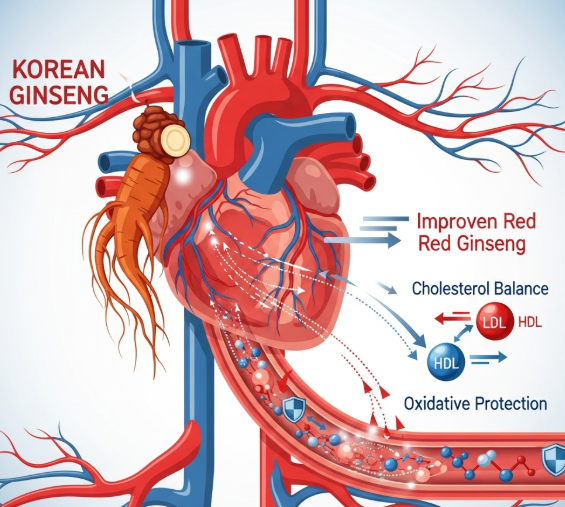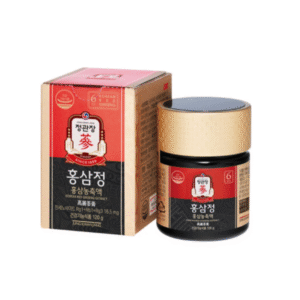Introduction
Cardiovascular health forms the foundation of human vitality.
Every heartbeat circulates oxygen and nutrients to sustain life — yet in modern living, chronic stress, poor diet, and metabolic disorders gradually weaken the heart and blood vessels.
According to the World Health Organization (WHO), cardiovascular diseases (CVDs) remain the leading cause of death globally, accounting for nearly 18 million deaths each year. Hypertension, dyslipidemia, and oxidative stress are the major contributing factors.
Recent advances in phytotherapy have highlighted Korean Red Ginseng (Panax ginseng Meyer) as a scientifically supported, natural ally for cardiovascular wellness. Its unique blend of ginsenosides, polysaccharides, and antioxidants helps regulate blood pressure, improve circulation, and protect heart tissues from oxidative damage.
This article explores, in depth, how Korean Red Ginseng supports the cardiovascular system through multiple biological pathways — combining traditional wisdom with modern clinical research.
💓 The Root of Vital Circulation
For over 2,000 years, Korean Red Ginseng has been described in Dongui Bogam (the Korean Medical Compendium) as a “vital tonic for the heart and blood.”
Unlike stimulants that merely raise blood pressure or heart rate, Red Ginseng promotes harmonized circulation — enhancing oxygen delivery without overburdening the heart.
When cultivated for six years and steam-processed, Panax ginseng undergoes biochemical transformations that increase its ginsenoside concentration and bioavailability — particularly compounds Rg3, Rb1, Rg5, and Rh2, known for cardiovascular protection.
⚙️ Mechanisms of Action: How Korean Red Ginseng Protects the Heart
The cardioprotective potential of Korean Red Ginseng comes from its multi-target biological effects.
1. Improves Endothelial Function and Blood Flow
Healthy arteries rely on a flexible endothelium to regulate vascular tone.
When oxidative stress damages these endothelial cells, blood pressure rises, and plaque formation begins.
Ginsenoside Rg3 has been shown to increase nitric oxide (NO) production, enhancing vasodilation and improving arterial flexibility.
In The American Journal of Chinese Medicine (2020), supplementation with Red Ginseng extract for 8 weeks improved endothelial function markers (flow-mediated dilation) in adults with mild hypertension.
➡️ Mechanism:
- Activates eNOS enzyme → boosts nitric oxide synthesis
- Enhances oxygen and nutrient delivery to the heart muscle
- Reduces arterial stiffness
2. Regulates Blood Pressure Naturally
Ginseng’s adaptogenic action supports cardiovascular equilibrium — it can lower high blood pressure (hypertension) or raise low blood pressure (hypotension) depending on what the body needs.
In Hypertension Research (2018), Korean Red Ginseng normalized systolic and diastolic blood pressure in patients with early-stage hypertension by modulating autonomic nervous system balance.
➡️ Key bioactive compounds:
- Ginsenoside Rb1: Regulates calcium channels in vascular smooth muscle
- Rg3: Promotes vasodilation
- Re: Reduces oxidative damage to arteries
3. Reduces Cholesterol and Prevents Plaque Formation
High LDL cholesterol and triglycerides contribute to atherosclerosis — the buildup of fatty plaques inside arteries that can lead to heart attacks and strokes.
Korean Red Ginseng works to improve lipid metabolism by:
- Lowering total cholesterol and LDL (“bad” cholesterol)
- Increasing HDL (“good” cholesterol)
- Reducing oxidative modification of lipids
In a meta-analysis published in Nutrients (2021), ginseng supplementation significantly improved lipid profiles and reduced triglycerides among adults with metabolic syndrome.
➡️ This makes it a natural adjunct therapy for individuals with hyperlipidemia or those seeking to maintain heart health without synthetic statins.
4. Protects the Heart from Oxidative Stress and Inflammation
Oxidative stress is one of the leading causes of cardiovascular disease progression.
When reactive oxygen species (ROS) accumulate, they damage vascular cells, LDL particles, and cardiac tissue.
Red Ginseng’s potent antioxidant effects — driven by ginsenosides Rb1, Rg1, and polysaccharides — neutralize free radicals and enhance the body’s endogenous antioxidant defenses, such as superoxide dismutase (SOD) and glutathione (GSH).
📚 In Frontiers in Pharmacology (2022), Red Ginseng extract significantly reduced cardiac inflammation and oxidative biomarkers in diabetic mice, suggesting benefits for both metabolic and cardiovascular health.
5. Improves Cardiac Energy Metabolism
The heart is an energy-demanding organ, relying on a continuous supply of ATP.
Ginsenosides, particularly Rg1 and Rb1, activate the AMPK-PGC-1α pathway, which enhances mitochondrial energy production and fatty acid utilization in heart cells.
This mechanism not only improves cardiac endurance but also protects the myocardium during ischemic events (restricted blood flow).
A study in the Journal of Ginseng Research (2020) found that pre-treatment with Korean Red Ginseng improved post-ischemic recovery in heart tissue, suggesting a protective role against myocardial infarction.
💪 Korean Red Ginseng and Exercise Endurance
For individuals seeking to improve stamina, cardiac performance, or recovery, Korean Red Ginseng offers measurable benefits.
A randomized double-blind trial (Nutrients, 2022) showed that athletes supplementing with Red Ginseng for 6 weeks experienced improved VO₂ max, reduced lactate buildup, and faster post-exercise recovery.
This combination of enhanced oxygen utilization and reduced oxidative stress makes it ideal not only for athletes but also for older adults managing fatigue related to cardiovascular inefficiency.
🩸 Korean Red Ginseng and Blood Circulation
Poor peripheral circulation often leads to cold extremities, dizziness, or sluggish recovery.
Red Ginseng improves microcirculatory flow, ensuring tissues receive adequate oxygenation even at the smallest capillary level.
In Phytotherapy Research (2023), ginseng extract increased peripheral blood flow velocity and reduced platelet aggregation, minimizing the risk of clot formation.
🧠 Mind-Heart Connection: Neurocardiac Health
Emerging research shows that cardiovascular and cognitive health are deeply interconnected.
Korean Red Ginseng supports this link by:
- Improving cerebral blood flow
- Reducing neuroinflammation
- Enhancing endothelial nitric oxide production in brain vasculature
This helps reduce the risk of vascular dementia and stroke-related cognitive decline — extending the benefits of ginseng from the heart to the brain.
⚠️ Safety and Dosage
Recommended dosage:
500–2000 mg/day standardized Korean Red Ginseng extract (≥5% total ginsenosides)
Safety:
Generally well-tolerated; mild insomnia may occur if taken late in the evening.
Consult a healthcare provider before use if on anticoagulants or antihypertensive medication.
🌿 Holistic Cardiovascular Lifestyle Synergy
To amplify the benefits of Red Ginseng:
- Adopt a heart-healthy diet rich in omega-3s, fiber, and antioxidants
- Engage in daily moderate exercise
- Manage stress with mindfulness and sufficient sleep
- Avoid smoking and excessive alcohol intake
Combining these lifestyle habits with consistent ginseng supplementation helps sustain long-term cardiovascular resilience.
🧩 Conclusion
Korean Red Ginseng is far more than a traditional tonic — it is a scientifically validated adaptogen that protects, strengthens, and rejuvenates the cardiovascular system.
By improving endothelial function, optimizing lipid balance, reducing oxidative stress, and supporting heart energy metabolism, it helps preserve the rhythm and vitality that sustain life itself.
As cardiovascular diseases continue to rise globally, embracing nature’s most respected adaptogen offers both ancient wisdom and modern protection for the heart.
🇰🇷 Premium Korean Ginseng Online Shop







